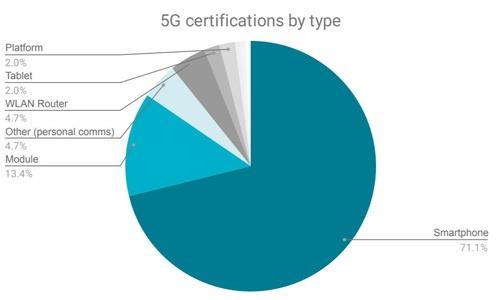Although much of the 5G industry's focus so far has centered on smartphones, new research from the Global Certification Forum (GCF) indicates that roughly one-fourth of all 5G device types are tablets, IoT devices and other gadgets beyond smartphones
Among other takeaways from the GCF's new report: The number of 5G devices supporting millimeter wave (mmWave) transmissions is increasing. And the number of 5G devices that can support the standalone version of the technology is also growing.
The GCF certified a total of 715 devices from 75 manufacturers during 2020. The group, founded in 1999, works to ensure the interoperability of mobile phones and other devices that incorporate mobile connectivity.
Thus, the firm's findings relate not to the overall shipment numbers of 5G devices but instead to the different types of devices that pass through its certification process. The firm's 2020 findings are illuminating:

Click here for a larger version of this image. (Source: GCF)
The firm said 94% of its 5G certifications in 2019 were either smartphones (63%, 10 devices) or mobile gateways and hotspots (31%, five devices). However, in 2020, 106 of the 149 certified 5G devices – or 71% – that passed through the GCF were smartphones. Just eight (5.4%) were mobile gateway devices. And the firm said the range of devices has increased significantly, with 20 modules (13%), 12 tablets, notebooks or other personal communication/consumer electronic devices (8.1%) and three platforms (2%).
Such findings are important considering 5G network operators are hoping to widen their businesses beyond smartphones by connecting a range of different types of devices to their networks.
The GCF's findings also help illustrate support for 5G in mmWave spectrum bands. Although US operators have long supported 5G transmissions in mmWave spectrum, most other operators across the world have focused on other spectrum bands. That's slowly beginning to change, however, as operators in countries like South Korea, Russia and China begin lighting up 5G connections in mmWave spectrum.
The GCF's figures help highlight the growth in the number of 5G devices that support mmWave spectrum bands:

Click here for a larger version of this image. (Source: GCF)
The firm said that 21% of the different 5G device types it certified in 2020 could access mmWave 5G frequencies.
The most popular 5G spectrum band, according to GCF's figures, was 2600MHz, with 91% of all 5G devices supporting that band. The 1900MHz band came in second, with 89% of devices supporting it.
The GCF's research also targeted the standalone version of 5G. The firm said 34% (or 50) of the 5G devices it certified supported standalone (SA) 5G.
That's noteworthy considering initial 5G market launches around the world generally focused on the non standalone (NSA) version of 5G. That's because the NSA version was finalized before the SA version. However, a number of operators – including T-Mobile, AT&T and Verizon – are working to move to the SA version of 5G in order to support technologies like network slicing.
"We expect to see that 5G will be supported in 40% of all devices certified during 2021, and that over 75% of these will support standalone 5G functionality," wrote the GCF in its report.
Finally, the GCF confirmed that the number of devices sporting 5G is growing at a quicker clip than when 4G LTE was first introduced.

Click here for a larger version of this image. (Source: GCF)
A number of 5G vendors have touted the speed at which the technology has caught on, and the GCF's figures bear that out.
